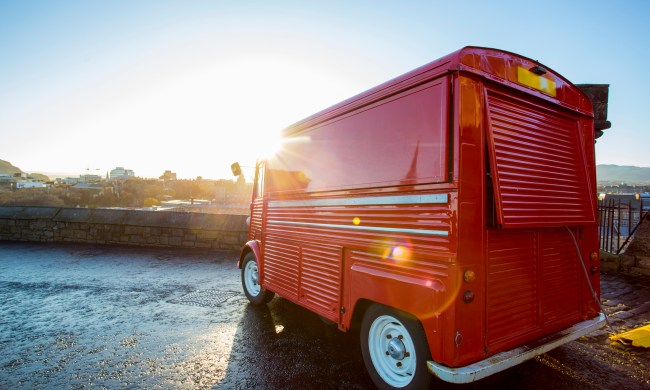Have you always wanted to try your hand as a professional chef? Or maybe you love food and want to share it with the world. If so, maybe you’ve considered buying and running a food truck. With food trucks, you have many options for mobility, reduced operating costs, and more.
The most successful food trucks are memorable for two reasons: the quality of the food and strong branding. Without a clear, recognizable name and design, it’s harder for customers who haven’t yet tasted your food to recognize your brand. Food truck design is all about sharing the flavor profile of your food in a visual format. Even with a great TikTok or Instagram following of your amazing food-making process, the visual elements help sell your food, too.
Discover what it takes to design a killer food truck and make your dreams of a mobile restaurant more than possible—but wildly successful. Read this guide for all the food truck design details you need to know.
What goes into food truck design?
Designing a food truck includes the interior and exterior. You have to consider the truck size you need or can afford. You also want to consider health codes about food prep and sales. These details will impact your food truck’s interior.
Once you determine the necessary equipment and ideal layout inside your truck, you need to design the outside of your food truck. This is where branding and other details come into play.
Dimensions and interior
Standard dimensions for food trucks are 14 feet, 16 feet, and 22 feet. The longer the truck, the more equipment you can fit inside, but the higher the cost of purchase, too. When you lay out your food truck interior, it’s important to evaluate the essentials you need to create your planned menu and cuisine. Some essentials may include:
- Sink: You need this for anything from dishwashing to sanitizing hands. Consider underbar sinks for smaller trucks or adaptive layouts.
- Water heaters: These are critical for keeping you and other chefs cool and they’re important for running some equipment.
- Meal cooking equipment: Consider countertop or portable versions to increase layout options.
- Food prep essentials: Commissary kitchens fit in compact places; alternatively, prep elsewhere if you lack prep space.
- Storage: You need this for on-hand ingredients that don’t require warming or refrigeration.
- Refrigeration: Consider under-counter freezers or refrigerators to conserve space. Installed units can hold more food.
- Oven range/grill/fryers: These vary based on cuisine, truck size, and menu items.
- Ventilation: This is essential for a safe workspace and it keeps employees cool and helps maintain health codes.
- Serving and register space: These areas are usually at opposite ends of the truck window. Customers pay and order on one end and receive food at the other end.
Branding and business details
Now you know what to consider for the inside of your food truck design, let’s look at what goes on the outside. Branding helps customers recognize your food truck. It also gives your business a boost with marketing and recognition, too. If you’re successful enough, it can even pave the way for merchandising, as well. Some branding elements to consider for your food truck may include:
- Graphics or wraps for logos
- Paint colors
- TV or LED restaurant signs
- Undercarriage lights for nighttime
- Backlit vs. handwritten menu signs
- 3D name signs
- Awnings, speakers, and more

How can I make my food truck stand out?
Of course, how you make your food truck stand out isn’t just about branding elements. It involves a clear understanding of some key business details, too. If you’ve never operated a food truck business before, here are a few details you’ll want to consider:
- Business plan: Outline who your customers are, how you’ll sustain the business, best and worst-case scenarios, and more.
- Health and safety: Compliance is key for keeping the business open.
- Permits: You need these for operating a food truck, a business, and where you sell goods.
- Leases: You need these for equipment, the truck, and anything you don’t own outright.
- Water containers: These are for food prep, sanitization, dishwashing, and more.
- Equipment: This is the key to your layout and business operation.
- Staff: This is how many people you need to run your truck.
- Service areas: This is where you sell your food.
- POS: Consider a point-of-sale system like Toast, Square, or Stripe.
- Marketing: This is important for you to attract new customers.
Planning out every detail of your food truck ahead of time can help your business stand out as a high-quality, established, and stable food truck operation. If you want to grow your business, understanding who you want to buy your food starts with paying attention to the details. You’ll only stand out if you know the best place to sell, how to sell it, and who you’re selling to.
How do food trucks attract and keep customers?
The simplest answer is word of mouth. Branding strategy is only part of a fully established marketing strategy. With the mobility of a food truck, you need people talking about your business.
If customers aren’t reviewing your business online, you’re not approaching them correctly. Although food truck design isn’t the same as designing or operating a restaurant, it’s still in the same industry. And your brand will only thrive if people are talking about it. Strong marketing depends on how well you plan out the menu and the memorable visual details of your food truck.


